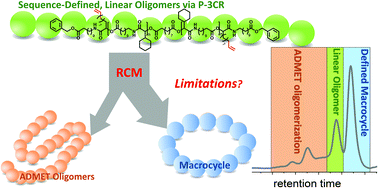Monodisperse, sequence-defined macromolecules as a tool to evaluate the limits of ring-closing metathesis†
Abstract
Sequence-defined macromolecules of uniform size unlock the door to many new applications in polymer chemistry, such as structure/property or structure/activity relationship investigations, which cannot be conducted accurately, if the investigated macromolecules exhibit dispersity. We herein demonstrate a first example by reporting the efficient and template-free synthesis of monodisperse, sequence-defined cyclic oligomers that are significantly larger than conventional large macrocycles (here >150 backbone atoms). Linear monodisperse precursors were utilized to evaluate the limits of ring-closing metathesis (RCM), manifesting clear trends depending on the ring size and introduced side chains. Furthermore, this work is the first example of a sequence-defined synthesis of a polymer architecture other than linear macromolecules.



 Please wait while we load your content...
Please wait while we load your content...